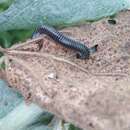en
names in breadcrumbs


Die Mandibeltiere (Mandibulata) sind eine monophyletische[1] Gruppe der Gliederfüßer (Arthropoda), die aufgrund von morphologischen Merkmalen gegen die Kieferklauenträger (Chelicerata) abgegrenzt wird. Benannt ist die Gruppe nach ihren Mundwerkzeugen, deren erstes Paar als Mandibeln bezeichnet wird. Die Mandibeltiere umfassen die Tausendfüßer (Myriapoda) und die Pancrustacea mit den Krebstieren (Crustacea) und den Sechsfüßern (Hexapoda), die u. a. die Insekten (Insecta) beinhalten. Einer älteren systematischen Einordnung nach wurden die Tausendfüßer und Sechsfüßer zu den Tracheentieren zusammengefasst und als Schwestertaxon den Krebstieren gegenübergestellt. Diese Tracheata-Hypothese ist jedoch stark umstritten. Molekularbiologische Untersuchungen führten zu der Annahme, dass die Krebstiere und Tracheentiere die Mandibeln unabhängig voneinander erworben haben.[2]
Die folgenden Merkmale verbinden die Mandibeltiere:
Die Mandibeltiere (Mandibulata) sind eine monophyletische Gruppe der Gliederfüßer (Arthropoda), die aufgrund von morphologischen Merkmalen gegen die Kieferklauenträger (Chelicerata) abgegrenzt wird. Benannt ist die Gruppe nach ihren Mundwerkzeugen, deren erstes Paar als Mandibeln bezeichnet wird. Die Mandibeltiere umfassen die Tausendfüßer (Myriapoda) und die Pancrustacea mit den Krebstieren (Crustacea) und den Sechsfüßern (Hexapoda), die u. a. die Insekten (Insecta) beinhalten. Einer älteren systematischen Einordnung nach wurden die Tausendfüßer und Sechsfüßer zu den Tracheentieren zusammengefasst und als Schwestertaxon den Krebstieren gegenübergestellt. Diese Tracheata-Hypothese ist jedoch stark umstritten. Molekularbiologische Untersuchungen führten zu der Annahme, dass die Krebstiere und Tracheentiere die Mandibeln unabhängig voneinander erworben haben.
Los mandibulados (Mandibulata) son un taxón de rango superior del filo Arthropoda. El concepto de Mandibulata es antiguo (Snogdrass, 1938[1]) y considera que los artrópodos con mandíbulas (crustáceos, miriápodos y hexápodos) forman un grupo monofilético. Su grupo hermano es el de los quelicerados, carentes de mandíbulas.
Numerosos estudios modernos, tanto morfológicos como moleculares, corroboran el monofiletismo de los mandibulados (entre otros, Giribet & Ribera, 1998[2] o Wheeler, 1998[3]).
En cuanto a las relaciones de los mandibulados ha habido controversias debido a que la teoría morfológica y tradicional consideraba que los hexápodos y miriápodos comprendían grupos hermanos,[4] sin embargo varios análisis moleculares y evidencias fósiles han demostrado que los crustáceos son los parientes más cercanos de los hexápodos y que de hecho los crustáceos serían un grupo parafilético del cual se originaron estos últimos:[5][6][7][8][9]
Algunos análisis moleculares antiguos habían sugerido que los miriápodos tendrían una relación más cercana con los quelicerados, sin embargo estudios moleculares recientes han recuperado a Myriapoda como grupo hermano de los crustáceos y hexápodos.[10][11][6][12][13][9]
Arthropoda Mandibulata Myriapoda Progoneata Edafopoda Pancrustacea Oligostraca Ichthyostraca Altocrustacea Multicrustacea Hexanauplia Thecostraca Allotriocarida Athalassocarida Labiocarida Hexapoda Ellipura Euentomata|url-status= ignorado (ayuda) |url-status= ignorado (ayuda)